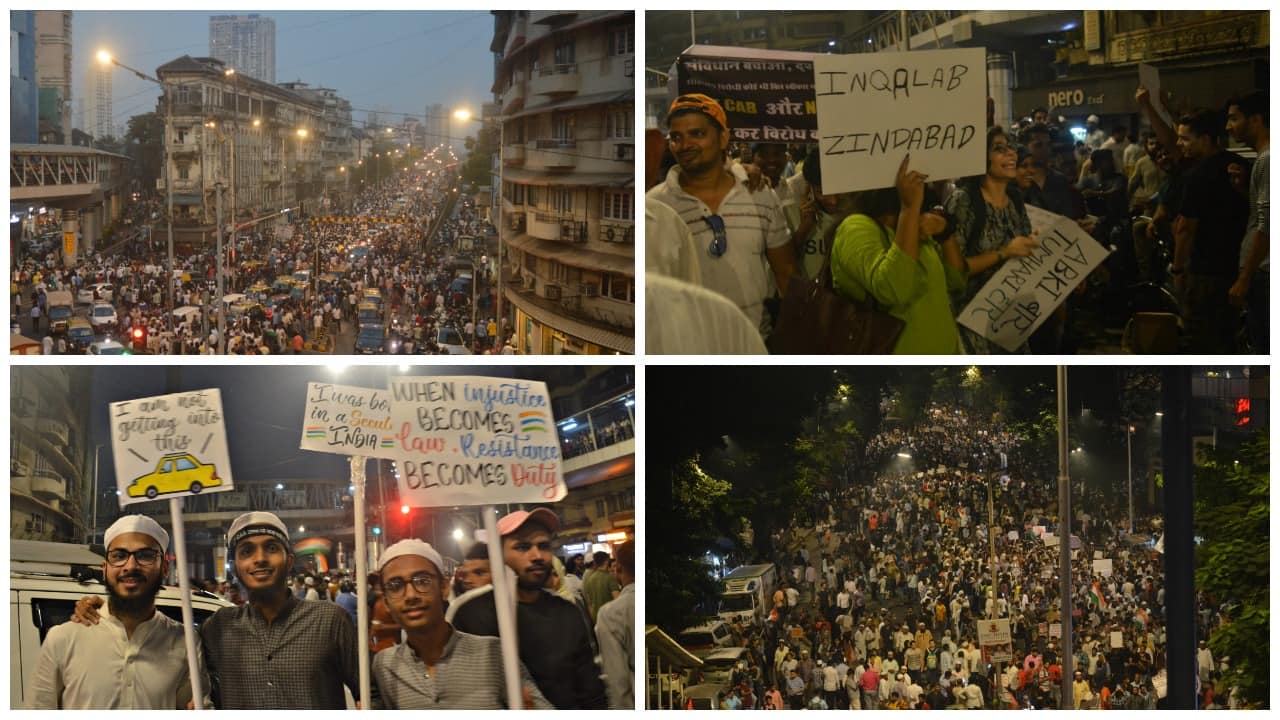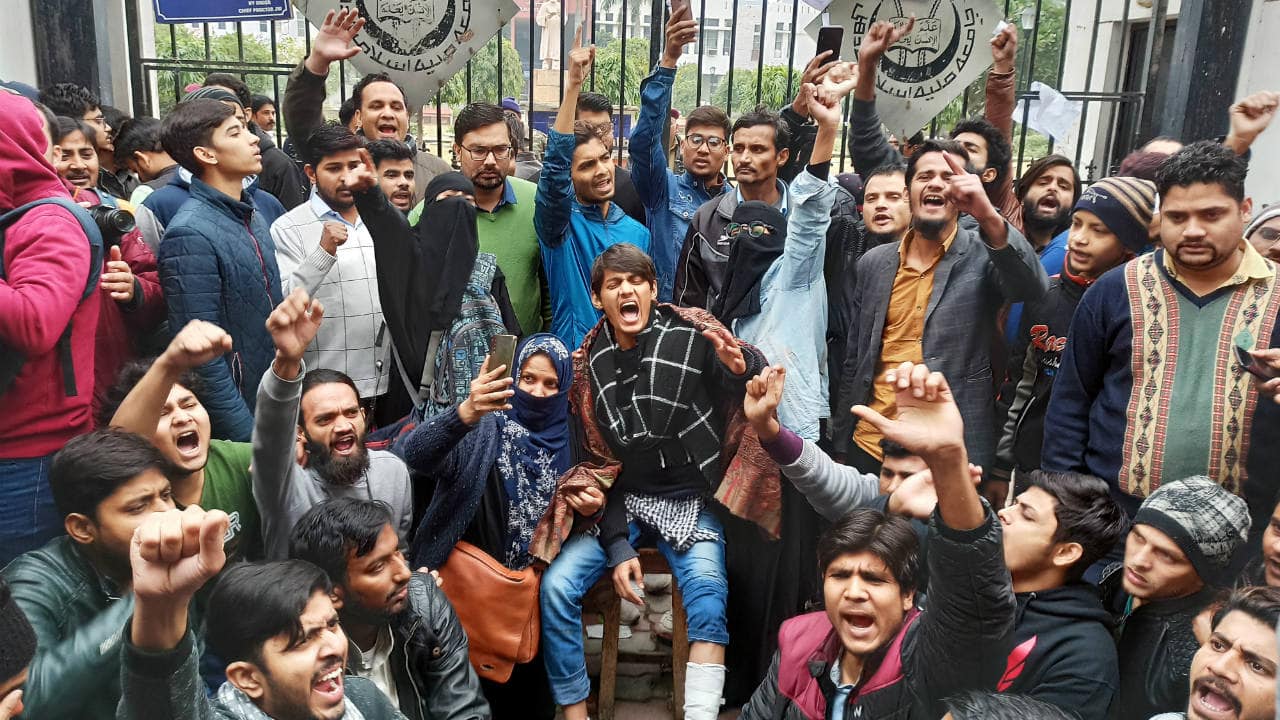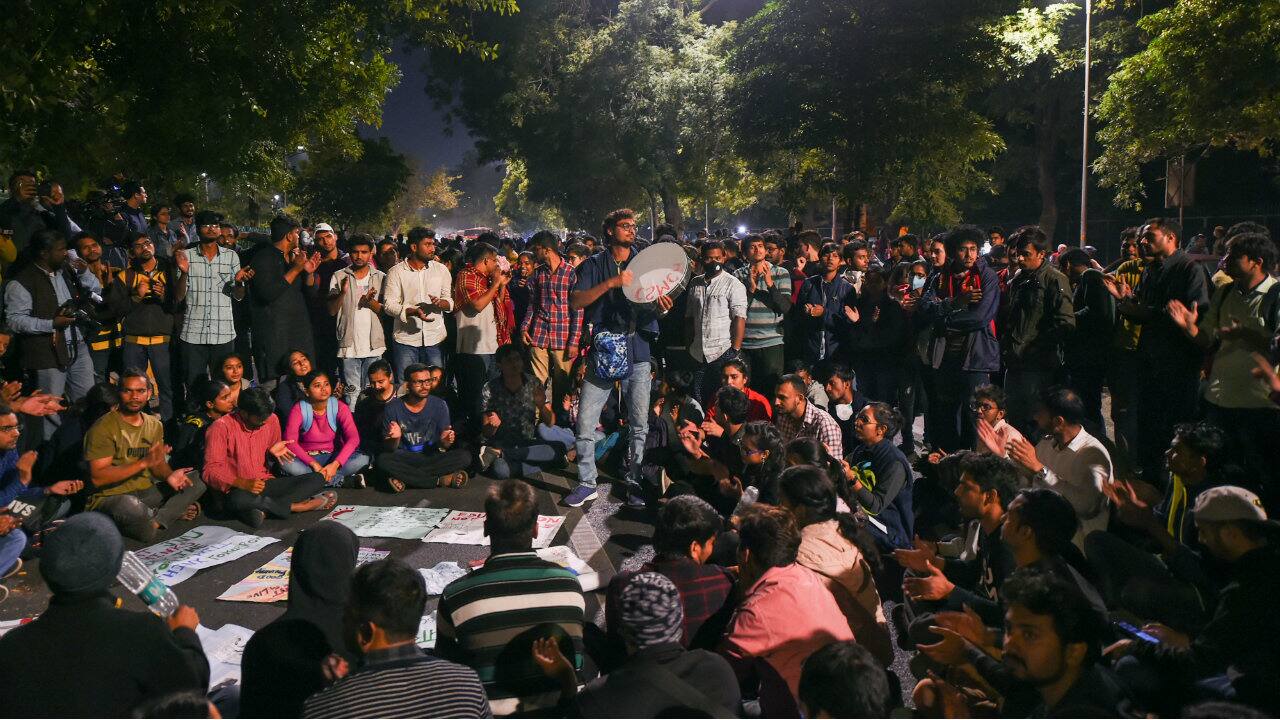



Protests erupted in parts of the Northeast as the Citizenship (Amendment) Bill, 2019, was passed in the Lok Sabha, and was set to be tabled in the Rajya Sabha.
The Bill, now cleared to become the Citizenship (Amendment) Act, 2019, is a contested legislation. It amends the Citizenship Act, 1955.
According to the CAA, persons who came to India from Pakistan, Bangladesh and Afghanistan till December 31, 2014, having faced religious persecution in their native country, will not be treated as illegal immigrants and would be eligible for Indian citizenship. However, this is only applicable to members of Hindu, Sikh, Buddhist, Jain, Parsi and Christian communities. Not Muslims.
Those opposing the amended Citizenship Act claim that granting citizenship on the basis of religion. They also claim that such “discrimination” is unconstitutional under Article 14 which says that "The State shall not deny to any person equality before the law or the equal protection of the laws within the territory of India."
Constitution experts suggest that Article 14 is not only applicable to Indian citizens, but also anyone who enters India.
Other concern raised by people, especially in the Northeast, is that it would alter the local demography. They also claim that the outcome of the Supreme Court-mandated National Register of Citizens (NRC) in Assam, which was carried out in accordance with the Assam Accord 1985, would also get “nullified”. Around 19 lakh people left out of the NRC in Assam. These include a large number of Hindus, reports suggest.
 Demonstrators raise slogans and hold placards against the amended Citizenship Act, at a planned protest near August Kranti Maidan in Mumbai, Maharashtra on December 19, 2019. (Image: Moneycontrol/Nachiket Deuskar)Demonstrators raise slogans and hold placards against the amended Citizenship Act, at a planned protest near August Kranti Maidan in Mumbai, Maharashtra on December 19, 2019. (Image: Moneycontrol/Nachiket Deuskar)Students at the forefront
Demonstrators raise slogans and hold placards against the amended Citizenship Act, at a planned protest near August Kranti Maidan in Mumbai, Maharashtra on December 19, 2019. (Image: Moneycontrol/Nachiket Deuskar)Demonstrators raise slogans and hold placards against the amended Citizenship Act, at a planned protest near August Kranti Maidan in Mumbai, Maharashtra on December 19, 2019. (Image: Moneycontrol/Nachiket Deuskar)Students at the forefrontThe CAA, even at its proposal stage, had been hotly contested and had faced severe protests form civil society, intelligentsia, local political outfits and students.
However, with this legislation becoming an Act, students were the first to hit the streets first.
Initial resistance was offered by the All Assam Students' Union (AASU), a students’ organisation from the northeastern state. AASU is best known for the Assam Movement agitation against illegal Bangladeshi immigrants in the 1970s and 1980s. The organisation has actively protesting against the CAA, even when it was a draft legislation.
However, this wave of student protests only snowballed into a pan-India movement late on December 15 following what transpired at a demonstration held by students of New Delhi’s Jamia Millia Islamia (JMI) University.
The student protest turned violent with DTC buses being set on fire and private vehicles being damaged in South Delhi. The university has claimed that the arson was carried out by outsiders, not the students.
Later that evening, the university virtually turned into a battlefield as Delhi Police entered the campus and allegedly used force leading to students as well as some police personnel getting injured.
The police detained many students, who were all released in the early hours of the following day.
 Students and others protest against the police action against students of the JMI university at Police HQ in New Delhi on December 15 night. (Image: PTI)Students and others protest against the police action against students of the JMI university at Police HQ in New Delhi on December 15 night. (Image: PTI)
Students and others protest against the police action against students of the JMI university at Police HQ in New Delhi on December 15 night. (Image: PTI)Students and others protest against the police action against students of the JMI university at Police HQ in New Delhi on December 15 night. (Image: PTI)JMI Vice Chancellor Najma Akhtar demanded an inquiry against police’s entry into the campus and “vandalism”.
The same day, police also entered the Aligarh Muslim University (AMU) and allegedly assaulted students. About 60 students were reportedly injured.
The visuals and reports of violence coming out of Jamia and Aligarh, led to solidarity marches from university students across the country.
Demonstrations were held by students from Mumbai’s Indian Institute of Technology - Bombay (IIT-B) and Tata Institute of Social Sciences (TISS), Banaras Hindu University (BHU) in Varanasi, Jadavpur University in Kolkata, Hyderabad's Maulana Azad Urdu University, Lucknow's Nadwa College, Chennai’s Indian Institute of Technology - Madras (IIT-M) and New Delhi’s Jawaharlal Nehru University (JNU).
Days later, they were joined by university students from Oxford, Harvard, Columbia, Yale and the Massachusetts Institute of Technology (MIT).
Calling violent protests “unfortunate and deeply distressing", Prime Minister Narendra Modi appealed for calm.
"Debate, discussion and dissent are essential parts of democracy but, never has damage to public property and disturbance of normal life been a part of our ethos," PM Modi said.
Finance Minister Nirmala Sitharaman said that activism, per se, was not new to universities and attributed it to “idealism” that guides a student because of his/her age.
However, she added that citizens should be wary of “jihadists, Maoists and separatists” getting into student activism, even as she said that she was not aware of the events at Jamia.
 Student protesters shout slogans during a demonstration outside a gate of JMI university in New Delhi on December 16. (Image: Reuters)Student protesters shout slogans during a demonstration outside a gate of JMI university in New Delhi on December 16. (Image: Reuters)
Student protesters shout slogans during a demonstration outside a gate of JMI university in New Delhi on December 16. (Image: Reuters)Student protesters shout slogans during a demonstration outside a gate of JMI university in New Delhi on December 16. (Image: Reuters)While the scale of youth protests surprised many, student activism has a long history in India.
In December 1973, public discontent in Gujarat against the state government reached its tipping point. Students of an engineering college began a protest against the hike in their food bills. These protests gained traction across the state and tuned into a socio-political movement led by students against economic crisis and alleged corruption, now referred to as the Navnirman Andolan.
The andolan later found support of political leader and activist Jayaprakash Narayan, commonly called JP, and resulted in the collapse of the state government.
In fact, PM Modi in his early 20s had himself participated in the movement. “As a young Pracharak and associate of Akhil Bharatiya Vidyarthi Parishad (ABVP), Narendra joined the Navnirman movement and dutifully performed the tasks assigned to him,” an article titled ‘When student power rattled the unhealthy status quo!’ published on PM Modi’s website illustrates.
Former union minister and senior Bharatiya Janata Party (BJP) leader late Arun Jaitley was also involved in the movement.
Having seen success in Gujarat, students in Bihar also started protests against misrule and alleged corruption in the state government. While JP was the lead figure of these protests, they were backed by student organisations linked to opposition parties. Students from ABVP, linked to the Jana Sangh, Samajwadi Party’s Samajwadi Yuvajan Sabha (SYS), the Lok Dal and Communist Party of India (CPI)-backed All India Students Federation (AISF) were involved in the protests.
JP termed the struggle as ‘Sampurna Kranti (Total Revolution)’.
The students then took on then Prime Minister Indira Gandhi’s government at the Centre. The movement has been credited with shaking the foundations of her government.
The agitation only ended after she declared Emergency on June 25, 1975, and JP was arrested.
It was the students that also led the Assam Movement between 1979 and 1985. The violent agitation was taken up by the All Assam Students’ Union (AASU) and the All Assam Gana Sangram Parishad (AAGSP). According to the Government of Assam, 860 people were martyred during this six-year period.
The agitation culminated with signing of the Assam Accord, by then Rajiv Gandhi-led central government and the AASU. The agreement fixed March 24, 1971 as the cut-off date for foreign immigrants. Those illegally entering Assam after that date were to be identified and deported, irrespective of their religion.
Those opposing CAA in Assam claim that CAA violates this Assam Accord, both in letter and spirit.
Fierce protests broke out in September 1990, when then prime minister VP Singh moved to implement the Mandal Commission report recommending reservation of 27 percent in government jobs for other backward classes (OBCs).
One of the striking images from the protests remain that of Rajeev Goswami, a Delhi University student, who attempted self-immolated against the move.
This act sparked a series of self-immolations by students and propelled the movement against reservation in government jobs.
While he survived the act of self-immolation, Goswami exited active politics due to health complications arising out around 50 percent burns he had suffered from. He died in 2004.
Surinder Singh Chauhan, a 22 year old who also self-immolated in front of hundreds of students, perished.
According to a 1990 report in the India Today magazine, over 159 people attempted suicide with 63 having died in the protests.
VP Singh’s governing coalition collapsed two months later.
On February 9, 2016, a group of students, at the behest of the then Jawaharlal Nehru University Students’ Union (JNUSU) President Kanhaiya Kumar, organised an event in the campus to commemorate Afzal Guru’s third death anniversary. Guru, a 2001 Parliament attack convict was hanged to death in 2013.
The event stirred a row with the ABVP staging a counter-protest demanding the expulsion of students and the varsity ordering a disciplinary inquiry into the matter, saying the event was conducted despite the administration denying permission.
ABVP members accused students at the event of chanting anti-national slogans. Students were seen chanting these slogans in a purported video that went viral.
A formal complaint was filed against unknown persons with Delhi Police for chanting anti-India and pro-Pakistan slogans, even though event organisers denied these allegations.
Then Jawaharlal Nehru University Students Union (JNUSU) president Kanhaiya Kumar was arrested on February 12 on charges of sedition. This sparked outrage among JNU students.
The demonstrations became a highly debated topic across the country with students from other universities coming in support of JNU students.
Also read: Unbowed, Unbent, Unbroken: An anatomy of JNU students’ protest against fee hike
In November, the campus was back in the public eye when protests erupted over a proposed hostel fee hike. At some point, the protest turned violent, with clashes between the students and the police. According to the police, around 30 of its personnel and 15 students were injured during the demonstration. The police also detained about 100 protesters.
 JNU students block a road as they protest demanding a total roll back of the hostel fee hike, in New Delhi Nov 18, 2019 (PTI)JNU students block a road as they protest demanding a total roll back of the hostel fee hike, in New Delhi on November 18. (Image: PTI)
JNU students block a road as they protest demanding a total roll back of the hostel fee hike, in New Delhi Nov 18, 2019 (PTI)JNU students block a road as they protest demanding a total roll back of the hostel fee hike, in New Delhi on November 18. (Image: PTI)In early 2015, students of the Film and Television Institute of India (FTII) in Pune agitated for 139 days in opposition to the appointment of Gajendra Chauhan as the institute’s chairman. They too found support across campuses.
In early 2017, thousands took to the iconic Marina Beach in Chennai, Tamil Nadu to protest peacefully against a ban on Jallikattu — traditional bull-taming contest.
While the Supreme Court had banned it in 2014 after objections from animal rights groups, the verdict was upheld the ban in 2016.
The movement was largely led by students who claimed that Jallikattu represented their identity. The demonstrations quickly spread through the state. At one point, 5,000 student agitators spent the night at the beach.
After 15 days of demonstrations, the Tamil Nadu state government was forced to pass a legislation legalising Jallikattu.
In the recent years, the internet has provided student activists in India, and elsewhere in the world, a platform to organise, regroup and communicate with their peers.
Filling the void?Even beyond India, student protests have been on an upswing. Take the case of Hong Kong, were youth, especially students, have been at the forefront of demonstrations seeking greater democracy in the special administrative region of China.
There too, protests, some of them violent, were witnessed at multiple university campuses in recent months. The siege at the Hong Kong Polytechnic University in November ended with the arrest of over 1,100 people — a large number of them were students.
Some attribute in the resurgence of student activism to the weakened standing of the opposition. In the absence of a strong opposition, students have filled that void, political analysts suggest.
Discover the latest Business News, Sensex, and Nifty updates. Obtain Personal Finance insights, tax queries, and expert opinions on Moneycontrol or download the Moneycontrol App to stay updated!
Find the best of Al News in one place, specially curated for you every weekend.
Stay on top of the latest tech trends and biggest startup news.